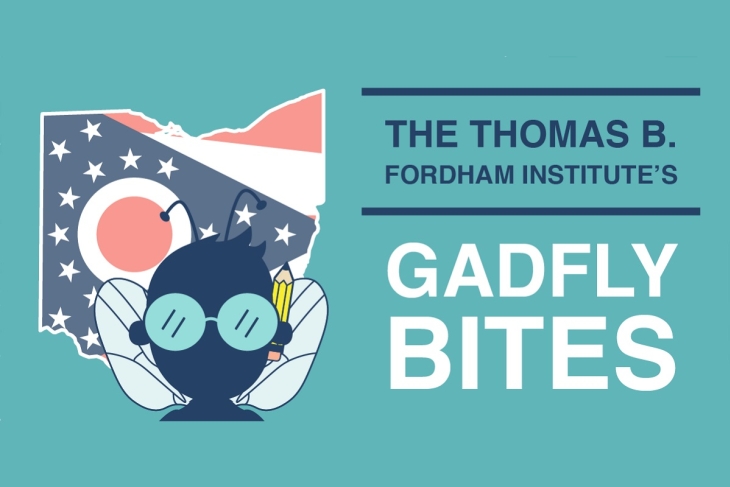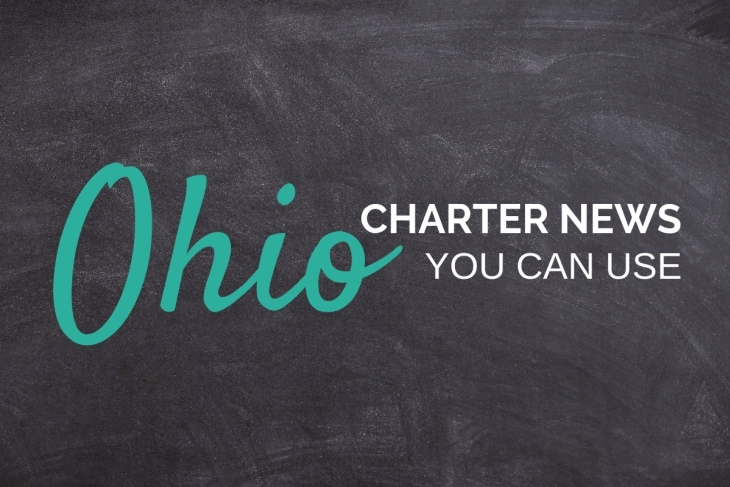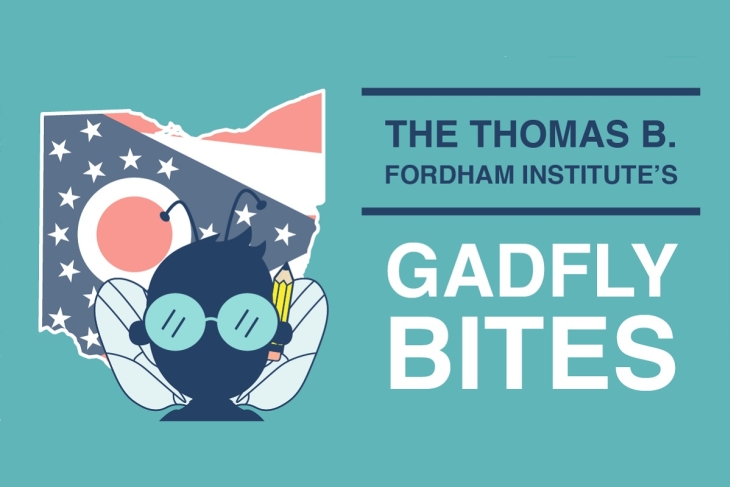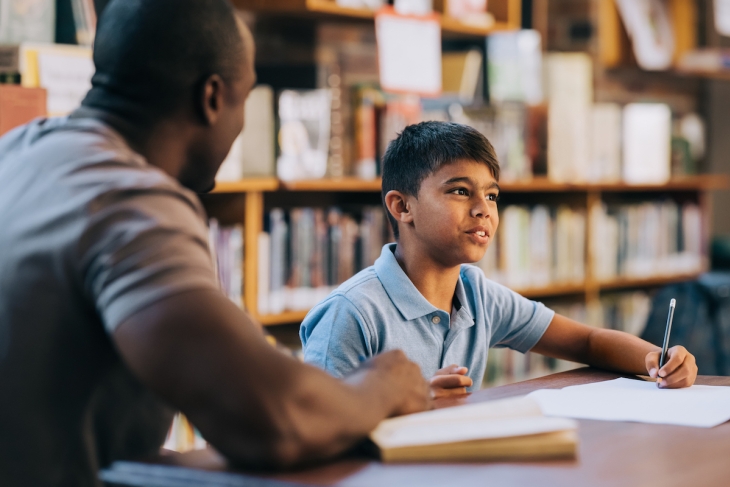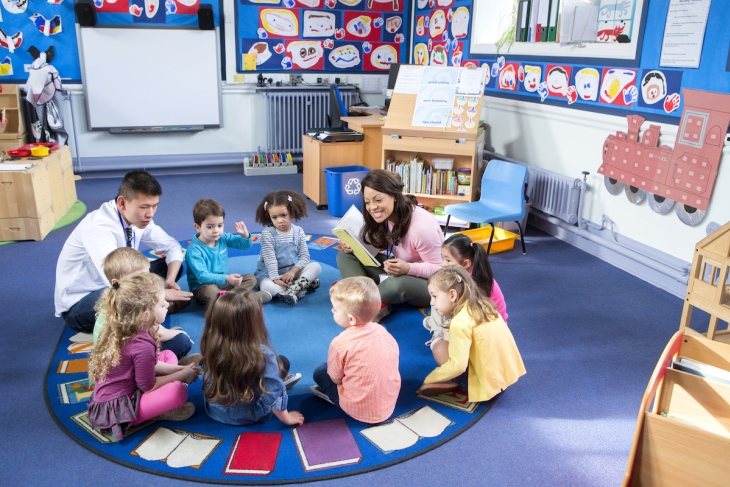In the shadow of a national reckoning on racial equity and in the wake of high-profile debates on the future of advanced (or gifted) education, the landscape of advanced education in the United States stands at a critical juncture. The controversies and challenges that have arisen in the world of advanced education signal a broader national conversation about how we value and nurture intellectual talent.
News stories featured in Gadfly Bites may require a paid subscription to read in full. Just sayin’.
- It’s nice to know that editorial boards read their own papers, I reckon. The good folks overseeing The Blade in Toledo certainly do, because they saw two separate stories published last week—Governor DeWine’s visit to Frogtown extolling the benefits of the science of reading and a new push by Mayor Kapszukiewicz to put free universal pre-K on the ballot—and decided this was an obvious two-fer worth opining on. (Toledo Blade, 4/21/24)
- Speaking of money to support kids (no, you’re right; I didn’t spell that out in the clip above, but honestly when are we not talking about that anymore?), there’s state grant funding available to help high school teachers become certified to teach college classes through College Credit Plus. It was interesting to me to hear the superintendent of the Montgomery County ESC discuss the results of a recent focus group of high school juniors and seniors, in which “most of them were clear” that they preferred to take their CCP classes in this manner—at their high school, taught by familiar high school teachers. These are still kids, the boss says, and they want to be able to do high school activities, like go to the pep assembly and hang out with their friends. (Dayton Daily News, 4/20/24)
- In the previous CCP clip, the ESC boss noted that “the schools that took advantage of these courses the most were already wealthy districts”. Meaning, in my mind, that the guiding principles for the entire program (as espoused by Madam Superintendent) are based on what those folks want, need, and ask for. I say all this as preamble for this clip, discussing the current cause célèbre in education policy everywhere: cellphone bans. The story is about how well a new ban is going in one school in Cincinnati these days. (Well, they always had a prohibition in the rule book, they say, but apparently no one really followed it until this year. Makes you wonder what other rules folks may be skating on at Cincinnati Country Day School, doesn’t it?) The main data provided here is that the kiddos are “cool with it” and, secondarily, one girl points out that she gets all her homework done during the school day now because she
cannot makeis not making TikTok videos during her Advisory period. Seriously? That’s it? Literally every action shot illustrating the story shows kids interacting with Chromebooks and wearing Apple watches. What, exactly, have they banned in this place, and, frankly, who cares? The Upper School tuition for this place averages $29K—going up to $30K for next year, so budget wisely Mom and Dad—and they do not appear to accept EdChoice vouchers. As good as this school may be, it does not, to my humble eyes, seem like someplace we should readily use as an exemplar for much of anything. Just sayin’. (Cincinnati Enquirer, 4/21/24) - Staying in the (somewhat similar) private school universe, here’s a story about Chaminade Julienne High School in downtown Dayton (annual tuition $14,100, EdChoice vouchers accepted—it’s only fair to compare, right?), which is raising funds for the next phase of its campus upgrades. The planned work will complete efforts of modernization, expansion, and consolidation of student services and will position the school for an expected increase in students. Expected because several affiliated K-8 Catholic schools in the area are already seeing big enrollment boosts. Just out of curiosity, I looked for info on their cellphone policy; didn’t find it, but I’m sure it’s there somewhere. (Dayton Daily News, 4/22/24)
- Finally today, here’s a quick look at the 2024 Regional FlexFactor competition, a multi-disciplinary geekathon held last Friday at Sinclair Community College. FlexFactor is funded by the Department of Defense and “aims to improve critical thinking, creativity, and collaborative skills, while informing students about career pathways in STEM…as well as advanced manufacturing.” Sounds like an awesome mash up of Science Olympiad, mathletics, and a job fair to me! Whatever it is, I came away curious to know how students got involved in order to compete. Teams this year came from one Dayton City Schools building, one county career center, one (the only one nearby) regional STEM school, and a bunch of suburban districts. Feels like there could be tons of other Future Dorks of America around (said with love, y’all, from this giant dork to all the others out there) who would probably love to strut their stuff. Here’s hoping they all get a chance someday soon! (Dayton Daily News, 4/19/24)
Did you know you can have every edition of Gadfly Bites sent directly to your Inbox? Subscribe by clicking here.
Last spring, state officials published data indicating that fewer young people are entering the teaching profession, teacher attrition rates have risen, and troubling shortages exist in specific grades and subject areas. In the weeks that followed, Ohio lawmakers took advantage of the biennial state budget to enact several policies aimed at addressing these issues. Their efforts included investing in Grow Your Own programs, making teacher licensure more flexible, and expanding the pool of substitute teachers.
These were welcome changes. But to ensure that Ohio has the teacher workforce it needs over the long haul, more changes are needed. In a 2022 policy brief—and a few other analyses on this blog—Fordham offered up some ideas. Let’s revisit three recommendations that could help boost the teacher pipeline.
1. Exempt out-of-state teachers from reading coursework requirements if they pass the state’s licensure exam on the first try.
Ohio offers teacher licensure reciprocity to out-of-state educators who wish to teach in the Buckeye State, but there are some limitations. For example, out-of-state teachers who wish to obtain a license in primary or middle childhood (grades pre-K–9) or any Intervention Specialist license must pass Ohio’s Foundations of Reading exam and complete twelve semester hours of reading coursework through an accredited college or university. In the past, applicants needed to complete at least six of the required twelve hours before being issued a license, though they were (and still are) permitted to apply undergraduate coursework toward the requirement.
The most recent state budget adjusted these coursework requirements for some out-of-state teachers. Now, applicants for a one-year, nonrenewable out-of-state license are not required to have completed at least six of the twelve required reading coursework hours if they pass the Foundations of Reading exam on the first try. That should make their transition to Ohio a little easier, as they can work to meet the coursework requirement while teaching on the temporary license. But they are still required to complete all twelve hours before they can advance or renew their license.
But requiring coursework at all—no matter how much—is a significant barrier, as taking these courses is expensive and time-consuming. That’s especially true for out-of-state teachers, who have already jumped through licensing hoops elsewhere. Passing the Foundations of Reading exam should be enough to signal that an out-of-state educator is qualified to teach literacy in Ohio. As such, lawmakers should allow teachers with valid out-of-state licenses who pass the exam on their first attempt to be exempt from all reading coursework requirements.
2. Allow out-of-state teachers trained by nontraditional programs to apply for a resident educator license if their training program has been approved by the state.
Ohio offers two pathways into the classroom for in-state teachers. The traditional licensure pathway requires candidates to complete a traditional teacher preparation program at a college or university and results in a resident educator license. The alternative licensure pathway requires candidates to complete a state-approved, nontraditional preparation program—known as an Alternative Licensure Institute—and results in an alternative resident educator license.
For out-of-state teachers, pathways into Ohio classrooms are based on experience. Educators with less than two years of teaching experience can apply for a resident educator license if they have completed an approved, traditional teacher preparation program through an accredited college or university. Teachers who have more experience—two full school years if they’ve completed a traditional preparation program, but three full school years if they haven’t—can apply for a professional license.
However, teachers who were trained in a nontraditional program but have less than three full years of teaching experience[1] must follow Ohio’s alternative pathway to obtain a license—which includes completing an approved Alternative Licensure Institute. This means that Ohio currently requires licensed out-of-state teachers (albeit those with less than three years of experience) to spend considerable amounts of time and money going through training that they’ve already completed in another state. On the one hand, this is a significant entry barrier for young and talented teachers who came to the classroom via nontraditional routes in other states. On the other hand, it ensures that relatively inexperienced teachers who were trained by nontraditional programs are exposed to the kind of pedagogical training that Ohio deems important.
Given the growth of nontraditional preparation programs nationwide—and the fact that not all of these programs are effective—lawmakers must walk a tightrope between widening the teacher pipeline and ensuring that educators who are granted licenses are well-prepared. One way to do so would be to require the Ohio Department of Higher Education to establish an approval process for out-of-state nontraditional programs. Programs that earn this approval would be granted license reciprocity that allows their teachers to apply for a resident educator license regardless of how many years of experience they have.
3. Bolster effective nontraditional teacher preparation programs.
The teaching profession hasn’t historically been friendly to career changers. Without a bachelor’s or master’s degree in education—and the time and money required to obtain them—it’s difficult to get into the classroom. Ohio could widen and strengthen its teacher pipeline if it offered high-quality programs that recruit recent college graduates and career professionals, train them, and then place them in public school classrooms.
Ohio data demonstrate that, although the number of newly licensed teachers coming out of universities has declined in recent years, the number of teachers coming from nontraditional pathways is rising. The numbers are still small—just 629 teachers in 2022—but nontraditional options are clearly appealing to more teacher candidates. Ohio leaders should pay attention and seize the opportunity.
They’ve already done so for one teacher training organization. State law currently includes a provision whereby participants in Teach For America (TFA) who meet certain criteria may be granted a resident educator license. This includes not only those who participate in TFA in Ohio, but also those who complete their TFA commitment in other states. In short, TFA is treated in the same manner as a traditional teacher preparation program that’s housed at a university, and TFA teachers earn the same license as their traditionally-trained counterparts.
However, TFA is the only nontraditional program that currently enjoys this privilege. There are other nontraditional programs that have been approved to train teachers in Ohio. But they must operate within the confines of the alternative licensure pathway. That means they must design or adjust their programming to fit within the parameters of an Alternative Licensure Institute (which candidates must complete to earn an initial license) and/or a Professional Development Institute (which candidates must complete to move on to a professional license, which is required to earn tenure).
This limitation could be why TFA is the only sizable nontraditional training program currently operating in Ohio. It’s the only one that isn’t required to adjust its existing model of pedagogical training to fit within the state’s parameters. Obviously, there are nontraditional programs that have been willing to jump through these hoops. But many of the established and effective nontraditional programs currently operating in other states might not be as willing to do so—and if their methods are producing effective teachers, they shouldn’t have to.
To widen teacher pipelines, state leaders need to make Ohio a welcoming place for as many effective nontraditional training programs as possible. As was the case with out-of-state reciprocity, this could be accomplished by establishing a process for nontraditional programs to gain approval through the Ohio Department of Higher Education to prepare participants for a resident—not alternative—educator license. Allowing nontraditional programs that can demonstrate the effectiveness of their methods to be treated the same as their traditional counterparts in colleges and universities could encourage the highly effective programs operating in other states to expand into Ohio.
***
Now more than ever, teachers matter. Students are still trying to catch up from pandemic-era learning loss. Achievement gaps remain stubbornly wide. And policies like Ohio’s science of reading initiative have the potential to improve outcomes for millions of kids. To address these issues, Ohio needs a strong pipeline of well-trained teachers. By implementing the recommendations outlined above, lawmakers could help make that happen.
Stories featured in Ohio Charter News Weekly may require a paid subscription to read in full.
Summer programming on the way
Kudos to Columbus Preparatory Academy, recipient of a grant from the City of Columbus to help fund summer programming this year. CPA was the only charter school to earn the award amid a big group of long-established institutions and programs.
Laboratory
Here’s an interesting look at an innovative microschool program in Indianapolis. Purdue Polytechnic High School’s Lab School has just 20 students, all of whom accepted the offer to participate in what leaders describe as “part one-room schoolhouse, part all-day advisory period.” The plan was to create a fully supportive educational model that individualized every aspect of the school day for students while still having access to the larger resources of the Purdue Polytech charter system.
Success story
The Editorial Board of the Washington Times called the growth of—and the competition from—charter schools a success story in the nation’s capital. Not just the charters themselves, but how well D.C. Public Schools upped their game in order to compete for students. “No matter which side one chooses,” they write, “the big winners have been D.C. children and their parents.” Nice!
The view from Florida
The votes are in and the proposals to convert three traditional district schools in Alachua County, Florida, into charter schools have all failed. Looking at the raw numbers, one might be confused, since there are more “yes” votes than “no” votes in some categories. However, the conversion rules are very detailed and the bar for success is high. Not coincidentally, a sweeping education bill sitting on Gov. Ron DeSantis’ desk would, among many other things, simplify these conversion and voting processes in the future.
The view from Missouri
Heading to Gov. Mike Parson’s desk in Jefferson City for signature: Missouri Senate Bill 727. It also addresses many areas of education, including early learning expansion, virtual course choice provisions, a teacher pay bump, and creation of a tax credit scholarship for private school students. Additionally, Boone County would be included for the first time in the list of counties where charter schools are allowed to operate in the state.
*****
Did you know you can have every edition of the Ohio Charter News Weekly sent directly to your Inbox? Subscribe by clicking here.
News stories featured in Gadfly Bites may require a paid subscription to read in full. Just sayin’.
- Governor DeWine hosted a number of events this week centering around the local screening of a documentary called “Right to Read”. The film follows an NAACP activist, a teacher, and two families who work to promote the vital importance of literacy as a matter of civil rights. Kareem Weaver, the activist shown in the film, was in Ohio for these events and he features heavily in this Dispatch coverage of the Columbus screening. (Columbus Dispatch, 4/18/24)
- Finally this week: YAYYYYYY!! Huge congrats to Fatima Abdulkadir, graduating senior at Metro Early College High School (seriously dude, this again?), who was awarded a ginormous college scholarship from Amazon to help her pursue her studies in computer design at Ohio State. And additional kudos—from one nerd to another—for saying that she’s passionate about computers…out loud and on the record. (NBC4i, Columbus, 4/15/24)
Did you know you can have every edition of Gadfly Bites sent directly to your Inbox? Subscribe by clicking here.
Phone bans are the hottest education policy since banning critical race theory. Districts across the country are strictly limiting their use, locking them in Yondr bags, or confiscating and sealing them away before the first bell. While surely a welcome development, I’m here to tell you, dear reader, that these bans don’t go far enough.
Walk through just about any school, and you’ll likely see students pull out their laptops to practice pre-algebra problems on Zearn, access their supplementary readings in English through Google Classroom, and watch a documentary on YouTube for history—and of course, they spend much of this time playing online games instead. For science, in place of a physical lab, new software allows them to perform the same experiment with virtual models. Even before the first bell rings, laptops lobotomize students with videos and online games. Screens capture attention from day’s beginning to end.
A recent Education Week survey found that the students spend at least one hour of daily class time on screens, with 27 percent of them spending five hours in this way.
There’s a story behind this colonization by devices. In the 2000s and early 2010s, schools underwent a techno-optimism fever. Various tutoring and academic software promised levels of personalization that no single teacher could render. Learning platforms like Google Classroom and Canvas provided user-friendly portals for classroom activities, grade management, and communication. The advent of the Chromebook, a simple, affordable student computer, meant districts could furnish every child with their own laptop instead of teachers herding twenty-five kids to the computer lab once a week.
Then, when the pandemic hit, everything went online. Teachers who may have dabbled with Google Classroom or experimented with Zearn uploaded all of their materials into the cloud and made online platforms a regular part of their classroom routine. Districts have spent tens of millions of Covid relief dollars on computers, software, tech services, and licenses for learning apps. Before the pandemic, two-thirds of high school and 40 percent of elementary school administrators reported providing devices to their students. After the pandemic, those numbers leapt to 90 and 84 percent, respectively. Learning went online for good.
To some extent, I get it. Google Classroom was a useful resource to me when I was a teacher. I didn’t have to worry about little Timmy losing his essay prompt...again. I could quickly access, grade, and organize what used to be unruly stacks of papers and assignments. I could send out communications to all students, provide feedback, and post useful academic support materials. But as I perused the research, I slowly rolled back my reliance on the platform.
For example, according to Scientific American, there’s a “steady stream of research” confirming that students learn and retain information better when they take notes by hand rather than tapping it out onto a document. The researchers posit two explanations. First, a basic insight of cognitive science is that we remember what we think about. Handwriting notes—a slower, anachronistic process—requires students to listen to classroom materials, process and synthesize the information, and write it out in our own words. Conversely, typing is so efficient that we can effectively transcribe everything in a lecture without really thinking about it. Second, when participants wrote by hand, sensors registered more connectivity across visual, information processing, and motor cortex regions of the brain as the physicality of shaping every letter fostered more brain activity whereas the action of typing every letter is functionally the same.
Similarly, a meta-analysis released late last year found that, when we read on paper, we better comprehend and remember what we read compared to when we read on screens—an effect that’s particularly strong for younger students. Digital devices have myriad distractions—hyperlinks, definitions, incoming texts, the entire internet—that pull our attention away from deeper reflection and consideration of the material. Even on a Kindle, the sensorimotor cues and physicality of a book can improve comprehension. We remember, if only vaguely, where in a book an event happened or in which paragraph of an article the author made a compelling point.
Finally, devices introduce a world of distraction into the classroom. Schools ban phones but allow access through one-to-one computing to many of the same diversions. Policy wonks might be unfamiliar with words such Slope, Dolphin Olympics, or Crazy Games, but these online games are a mainstay of modern classrooms. Unsurprisingly, recent research has found that off-task behaviors not only hamper the learning of the student playing (duh), but also distract and negatively affect the achievement of peers. It’s hard to focus on geometry when your elbow partner is shooting aliens on their screen or watching a movie.
Even so, a handful of research reviews find small positive impacts from one-to-one computing initiatives. In other words, while students learn poorly on computers compared to physical texts, providing every student a computer can improve learning. How are we to make sense of this seeming contradiction?
A behemoth UNESCO report on technology in the classroom released last year can help to square this circle. The authors conclude that “systematic reviews of the past two decades find a small to medium positive effect of education technology on learning outcomes,” but the use of devices beyond a moderate threshold “may have a negative impact on academic performance.” Technology proved beneficial as a supplement—as an opportunity for extra practice, for example—but not when it “substituted for human instruction.” Per the report, screens and keyboards have replaced pen and paper.
A good rule of thumb might be: If the activity is no different on screen or paper, use paper. For example, when teaching Shakespeare, I always had my students complete a “virtual tour” on the Globe Theater’s website; pictures don’t accomplish the same task, so I used computers. But all readings, questions, and the text of Shakespeare itself remained analog.
I’d wager that the sharp increase in screen time since the pandemic is so drastic that it represents a difference in kind, not just degree. Watering the grass can foster a healthy lawn; flooding the lawn can suffocate the grass.
Noah Smith, writing in his Substack newsletter last week, argues that Americans are imprudently burying their heads in the sand at the increasing prospect of a global Sino-American clash. Along with Xi Jinping’s massive military and technological buildup, China is fast outpacing the U.S. in training its young people for STEM fields that are vital for national security. If a hot war between the U.S. and China were to erupt, K–12 education policy will be far from top of mind. But that’s the realm where I belong, so let’s consider how America’s schools might better prepare our students to contribute to a victory against China should a collision occur, and how we need to ramp up teaching and learning to meet the moment.
According to Smith, the key problem is that America remains at a peacetime posture, even as China is increasingly on a wartime footing:
As I see it, the mere fact that not many people are talking about the danger [of WWIII] represents evidence that we’re still not taking it seriously. And because Americans aren’t talking about it, our country doesn’t have the urgency required to do something about it. One of our great strengths as a nation has always been that we start shouting about problems before they become severe, giving us time to prepare. Right now, we’re not shouting, so we’re not preparing.
When it comes to schooling, we’re doing plenty of shouting, but not about student achievement and global preparedness. Instead, the debates that dominate our sector today are largely unserious and too often of the navel-gazing variety. Breaking out of the doom loop will require thinking both big and small and getting back at the real problems that face American K–12 education with renewed energy and enthusiasm.
The stakes couldn’t be higher; the Council on Foreign Relations said as much in its report—produced by Joel Klein and Condoleezza Rice—on U.S. Education Reform and National Security back in 2012:
Human capital will determine power in the current century, and the failure to produce that capital will undermine America's security. Large, undereducated swaths of the population damage the ability of the United States to physically defend itself, protect its secure information, conduct diplomacy, and grow its economy.
Indeed, a national commitment to building a much stronger STEM pipeline is required. There’s no better way to do this than by ensuring that every student has a strong foundation in mathematics.
A good place to start would be dusting off the National Math Advisory Panel’s 2008 report, which has gone largely unheeded over the years. Modeled after the National Reading Panel, the math group similarly used the best available evidence to help guide its recommendations, calling for students to be proficient in arithmetic—my third-grade daughter knows her times tables cold—and standard algorithms as part of a coherent progression leading to success in algebra.
The aim is to ensure that all students are well-positioned and well-prepared to access advanced math in high school, which is difficult, if not impossible, if they don’t take Algebra I by eighth grade. As it stands, states are all over the map when it comes to offering the course, but they can flip the script by following North Carolina’s and Texas’s lead:
A new Texas law signed by Abbott [last] May calls for middle school students in the state to be automatically enrolled in advanced math if they score in the top 40 percent of the state’s exam. The new practice will likely increase the number of students ready to enroll in algebra in the eighth grade, especially Black and Latino students who have historically been shut out of advanced math courses. In Dallas ISD, the policy has increased the share of Black sixth graders from 17 percent enrolled in honors math to 43 percent; the percentage of Latino sixth graders from one-third to nearly 60 percent. In high school, this should translate to more Black and Latino students in calculus and statistics.
Because every state is required to assess student academic progress annually through eighth grade, it would be relatively simple for state lawmakers to require schools and districts to leverage their standardized math testing data for automatic enrollment decisions.
Some states are exploring other promising practices to boost math performance, but strong and strategic state leadership will be required to keep these efforts moving forward. The lack of seriousness from Washington, D.C., makes this all the more urgent. At the same time, state leaders need to insist upon academic excellence and to stop sugarcoating the setbacks that students have suffered post-pandemic.
Along with a renewed focus on math and the STEM pipeline, vocational training and workforce readiness must also move to center stage because—for example—the need to modernize the Navy will require both manpower and brainpower. Strengthening education in foreign languages may also be part of the war effort, though the provision of Chinese language classes has at times been met, understandably so, with skepticism.
Not so long ago, K–12 schools were improving at a steady, if modest, clip, especially in math, but we’ve since lost our way. As a country, we need to double down on world-class teaching and learning and expand access to advanced mathematics for as many students as possible. At the risk of being trite, this could be a real Sputnik moment. There’s no time to waste in regaining our bearings as the emerging anti-democratic alliance led by China grows ever more emboldened.
A few weeks ago, I was sitting in an eleventh-grade history class at a high school in the suburbs west of Chicago. Mr. DiTella was firing off questions about the civil rights movement and getting precious little in return, despite the fact that he had assigned a reading on the subject. When we spoke afterwards, Mr. DiTella complained about how little reading the kids were prepared to do, and how brazenly nonchalant many of them were about handing in written assignments. That’s an immemorial lament; what has changed the conversation is the all-consuming presence of social media. Mr. DiTella recalled watching his daughter, a student so diligent that she was considered practically freakish by her friends, scroll through her TikTok or perhaps Instagram feed. Her rapid-fire reaction had gone something like this: laugh-pause-laugh-laugh-pause-pause-laugh. “Each one is a dopamine hit,” Mr. DiTella recalled thinking. How can school compete with that?
The general answer is: Schools don’t try. Almost all the schools I’ve seen have learned to accommodate students’ ever-dwindling attention span with ever-shorter assignments, with video rather than text, with one paragraph of writing rather than a page. The response is equal parts abject surrender and progressive doctrine; if, as educators have believed since the time of John Dewey, successful learning rests upon student interest and student preference, then schools need to work with, rather than push back against, the cognitive habits imposed by social media. So they do.
Here, I have come to think, is the real battle line. Those of us who think about civic education are mesmerized by the shiny bauble of politics. Florida demands patriotism; Minnesota demands respect for diversity; purple states hold pitched battles between the woke and the anti-woke. It’s highly entertaining. But the deepest crisis in the school is not ideological; it’s cognitive. Kids who spend their entire lives on their phone are losing the skills required for reflective citizenship, no matter their point of view. If we care about preparing young people for democratic citizenship, that is the fight we need to wage.
In an excerpt in The Atlantic from his book The Anxious Generation, Jonathan Haidt writes that the world changed about a decade ago when smartphones began delivering curated feeds of social media to young people’s pockets. Haidt, too, describes the dopamine hit, though his chief focus is mental health. “When the child is not engaged in digital activity,” he writes, “the brain doesn’t have enough dopamine, and the child experiences withdrawal symptoms,” including anxiety and insomnia. That’s bad enough; but Haidt also notes that social media undermines acts of sustained attention with incessant ping notifications and an endless stream of “high-pleasure, low-effort digital experiences.”
All schools recognize the deleterious effects of smartphones, but many are reluctant to simply prohibit something so central to children’s lives. Classrooms in Mr. DiTella’s school have what’s called a “phone tree,” a kind of hanging shoe bag in which teachers may, if they wish, ask students to place their phones at the beginning of class. Most of the trees I saw were empty. A study by a mental health organization found that 97 percent of students use their phones during the school day, with the most popular functions being social media, YouTube, and gaming.
Florida, which leads the nation in banning things like “critical-race theory” that oughtn’t be banned, has also banned the use of phones in schools and access to social media on school Wi-Fi. Haidt favors such rules; I do, too. But prohibiting the use of bad things does not ensure that good things will take their place. Social media has killed off sustained acts of reading. A study by the American Psychological Association found that while in the late 1970s, 60 percent of twelfth-graders reported reading a book or a magazine every day, the figure had plummeted to 16 percent by 2016. It’s almost certainly fallen further since then. I asked twelfth-graders in an elective sociology class at the suburban high school—middle-class kids in a group self-selected for intellectual curiosity—how many read books at home. Five or six out of thirty raised their hands. One kid was reading Stephen King. But of the two others who volunteered, one shuffled through mystery books whose titles she couldn't remember and the other was reading what she called a “slice-of-life” book, by which she meant a book about an unhappy teenage girl like herself.
A truly counter-cultural school today is not one that teaches that the Pilgrims were settler colonialists or, on the contrary, that we should idolize Thomas Jefferson; it is one that restores books to the center of children’s experience. And by “book” I do not mean any sheaf of paper glued together and bound between covers; nor do I mean “great books.” Stephen King will do. Students need to have experiences that will both demand sustained attention and repay sustained attention. Slice-of-life books don’t demand it, and Hamlet, at least for many students, won’t repay it. Nor does it matter whether students read books on paper or on a screen, just so long as the experience makes them ignore the ping.
What does this have to do with civic education, and thus with democracy? Many of the students I talk to go to TikTok or Instagram to learn about serious things like the war in Gaza, as well as about inane ephemera. But they learn about real things without history, context, or balance. Social media reinforces kids’ natural tendency to seek simple and self-reinforcing answers to hard questions. If it can’t be explained in thirty seconds, it’s not worth knowing; worse still, it’s not knowable, since kids stop paying attention. These children are being perfectly prepared to join a society already aflame with self-righteous certainty.
Our world of algorithmically curated dopamine hits is not going away. In fact, Tiktok and Instagram will seem positively quaint once we fully enter the world of artificial intelligence. The New York Times just revealed that officials at Meta contemplated buying Simon & Schuster just to have more stuff to load into their AI’s maw. AI aspires to reduce all knowledge to data. The only way to prevent this monstrous flattening is to thicken the walls of the institutions charged with shaping our minds, above all our public schools and colleges; that is, to ensure that what happens inside them is genuinely different from what goes on outside them. Social media may rule outside; books, and the depth experience that comes with them, must rule inside.
I am convinced that the growing popularity of so-called “classical schools” is evidence of the deep discomfort many parents feel with their kids’ peer culture. Whatever else they do, classical schools, very much including public charter schools, revere books and disdain technology. The average public school seems to do the opposite. Of course public schools by their nature reflect the community in which they are situated. But doctrine matters, too; and the progressive deference to the student prevents schools from seeing how very destructive her culture has become. Most kids seem to want to be liberated from the technological forces that have increasingly taken over their lives and their minds. Schools must take their side.
Editor’s note: This was first published on the author’s Substack, A Democracy, If You Can Keep It.
Across the country, schools are working to help students recover from pandemic learning losses. A new report, part of the Personalized Learning Initiative from the University of Chicago, examines high-dosage tutoring efforts and aims to provide some up-to-date evidence on how effective they’ve proven thus far.
The data come from four education agencies—three traditional districts and one state department of education—with which Initiative researchers partnered during the 2022–23 school year. These were chosen because they all implemented high-dosage tutoring programs in an effort to follow federal guidance “about how to deploy their ESSER dollars to overcome pandemic learning loss.”
The top-line findings are easily summarized: Tutoring can be implemented at scale and clearly boosts participating students’ end-of-year test scores. The overall impact on math scores is equivalent to about two-thirds of a year of learning, which would be enough to reverse the effects of pandemic learning loss for the average student. Reading test scores are generally positive but far less significant.
Breaking things down further, the analysts find that providing tutoring services during the school day is key to successful implementation. Two of the agencies studied—the New Mexico Public Education Department and an anonymous mid-sized urban district in California—both used out-of-school tutoring in 2022–23, with the former offering online services that could be accessed from home and the latter offering a formal afterschool program. Student participation was low for both programs (the California district didn’t even launch its tutoring until well after the start of the school year), and students who did participate saw minimal improvement in test scores compared to their non-participant peers.
The other two agencies—Chicago Public Schools and Georgia’s Fulton County Schools—focused on tutoring during the school day, and the report presents a detailed analysis of their efforts. Specifically, analysts followed 548 students from Chicago Public Schools and 1,506 students from Fulton County Schools. About half of the group from each school system was randomly assigned to receive high-dosage tutoring in math or reading in addition to classroom instruction, while the other half received classroom instruction only. Among the pooled sample from both districts, 76 percent of students assigned to tutoring participated in at least one session, and the average participating student took part in seventeen sessions. As noted above, data on reading test scores were considered “too noisy” to allow for conclusive evidence of impacts, but indicators were generally positive. Math impacts, however, were strongly positive across the board. The report cites additional factors that aided these outcomes, including having a consistent schedule, deploying well-trained and fully-supported tutors, and using a structured curriculum aligned with the school’s classroom instruction.
The bottom line here: High-dosage tutoring works and is still a powerful weapon to fight learning loss, especially in math. But the authors point out that all four of the education agencies relied on federal ESSER funding to pay for their tutoring programs. With that funding expiring by the end of September 2024, the current school year could be the last for many such programs, despite their demonstrated successes. Unfortunately, they have no recommendations for how to ensure funding support—the question of what happens to pandemic recovery efforts after the “fiscal cliff” is a vital one without clear answer—but their hope is that sharing these promising findings will bolster the case for continuation (and perhaps even expansion) with whatever funding sources can ultimately be found.
SOURCE: University of Chicago Education Lab and MDRC, “Realizing the Promise of High Dosage Tutoring at Scale: Preliminary Evidence for the Field” (March 2024).
High-quality early childhood education (ECE) offers a promising means of boosting both achievement and equity, yet districts and states across the nation face educator shortages, budget cuts, and inequities in accessibility. Given these challenges, along with the variable quality of ECE programs, policymakers and educators must ensure that limited resources are targeted toward the most effective programs. A new study by researchers from the University of Michigan, the National Bureau of Economic Research, Mathematica, and RAND investigates whether a relatively new model, dubbed “transitional kindergarten” (TK), leads to better outcomes for children in Michigan.
TK is essentially another public schooling option for the year that precedes kindergarten. Unlike most ECE options, it operates much like K–12. That is, TK students receive funding comparable to that of their K–12 counterparts, TK teachers must meet the same licensure requirements as K–12 teachers, and they are expected to follow a particular evidence-based curriculum. Further, and in stark contrast to many ECE teachers’ struggle to earn a living wage, TK teachers are compensated more like their K–12 peers. Over the last decade, public TK programs have been rolled out in California, Washington State, and Michigan. Until now, researchers had only studied California’s TK (finding either neutral or positive effects).
The present study is the first to take a closer look at TK outcomes in the Great Lakes State. There, children who turn five between September 2 and December 1 have three options: They can enroll in TK, waive into traditional kindergarten early, or pursue other public or private care. Relying on what researchers call regression discontinuity design, the study compares outcomes for TK and non-TK students with birthdays near the December 1 cutoff. The sample is limited to Michigan school districts that offer TK and to students who turned five in either 2014 or 2018. (The researchers exclude five-year-olds from the 2015–2017 cohorts because pandemic-era school closures interfered with subsequent testing.) Their model controls for demographic factors like sex, race, and economic disadvantage, and the key outcomes are third-grade math and English languages arts (ELA) test scores.
They find substantial academic benefit to TK. According to their calculations, it boosts third-grade math scores by 0.29 standard deviations and ELA scores by 0.19 standard deviations, compared to what would have been predicted for the same students starting kindergarten on time or later, attending public or private pre-K, or spending the year at home. One caveat is that, due to the study’s focus on children born shortly before and after the December 1 cutoff, these estimates reflect TK’s impact on students who are relatively “old” for their cohort.
Nonetheless, the findings offer promising evidence supporting TK, especially given that third-grade test scores are, for better or for worse, accurate predictors of academic performance nearly a decade later. States and districts looking to boost student achievement, especially as young children continue to struggle academically, may want to follow Michigan’s lead.
Unfortunately, the very factors that likely make TK so beneficial—qualified teachers, fair teacher pay, high-quality curriculum—also make it expensive. The TK year itself comes at significant additional cost, of course. There is also the fact that some families choosing TK for their children would otherwise have chosen early entrance to kindergarten; in these cases, the TK option thus adds another year of public education to the tab. Especially because TK participation has no income cap (at least in Michigan), private ECE providers may also push back against efforts to expand the program. Policymakers considering TK will therefore have to weigh fiscal and political concerns against the growing body of evidence supporting the new program.
SOURCE: Jordan S. Berne, Brian A. Jacob, Tareena Musaddiq, Anna Shapiro, and Christina Weiland, “The Effect of Early Childhood Programs on Third-Grade Test Scores: Evidence from Transitional Kindergarten in Michigan,” National Bureau of Economic Research Working Paper Series (April 2024).
